“Appreciate this moment,” I tell myself, “because it’s a gift.”
Not that I’m grateful for this exact moment, necessarily. At this exact moment I see a lump of snow approaching that I know is going to bounce me into the air and jolt my hand hard into the throttle right when I least want to. Thump. I’ve had two days of experience driving a snowmobile, and it shows against the pace of the men I’m following. They ride their machines with nonchalant impatience, standing up; I cling low to mine, expecting it to corkscrew through the air like a sedan in a Hollywood chase scene. I look forward to the space between rough patches, when I can relax and look around. I can’t remember a place so blank. Flat snow reaches every horizon, with a low layer of clouds meeting it at the seams. In a way, it reminds me of the sagebrush steppes near where I grew up. Landscapes you can get lost in, even when you’re sitting still: nothing in particular draws your eye, so you drift between shifts in tone, the movement of shadows. My snowmobile bucks unexpectedly, shaking me back to attention.
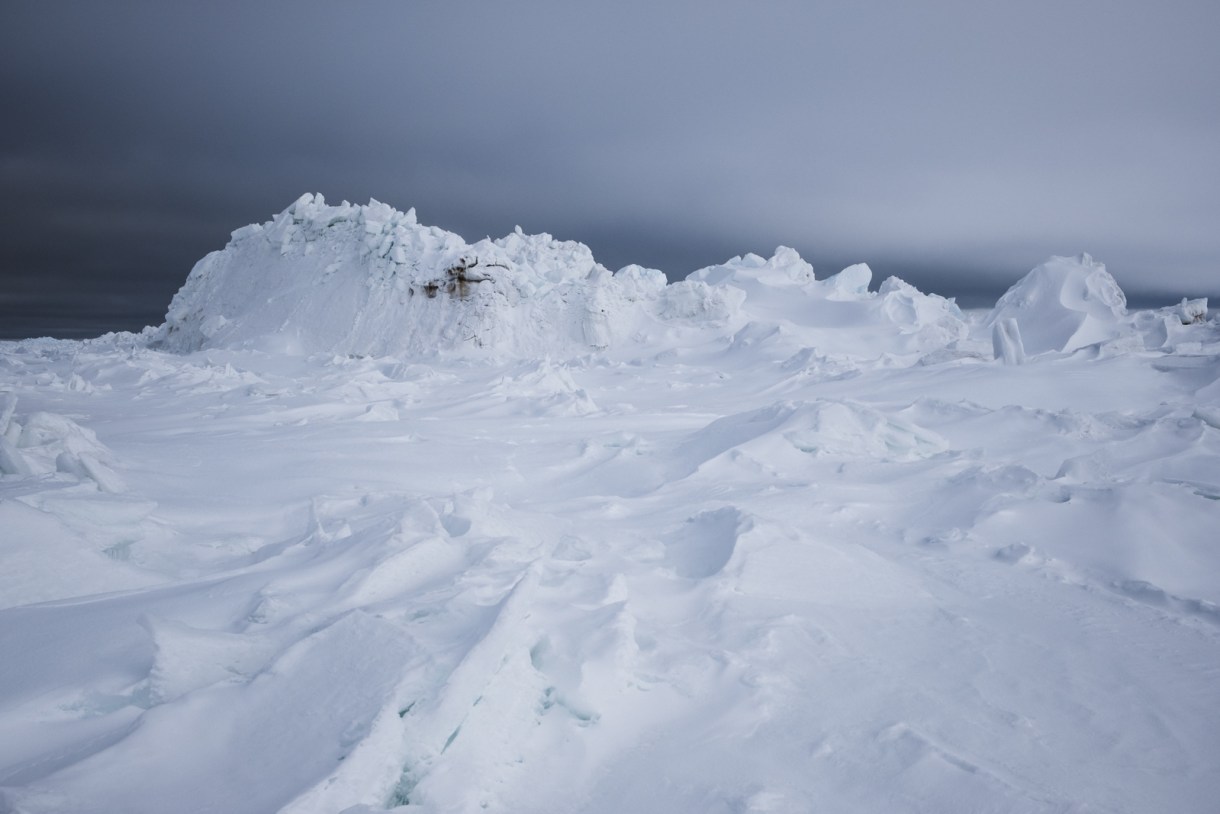
Out on the sea ice. (All photos by Allyson Woodard)
I’m in this place because I’m researching an exhibit about snow. The scientist co-leading our project, a man named Matthew, thought I should get my hands on the stuff before I tried to teach other people about it, so he invited me into the field at the northern tip of Alaska, outside a village called Utqiaġvik, where he’s studying snow’s impact on the global climate. For the past two days I’ve been helping his research team set up experimental field sites where they’re measuring how much of the sun’s energy melting snow reflects back into space. Snow is white because most wavelengths of light bounce off it (scientists call this a high albedo).
Every year, this vast natural mirror blows across the northern and southern corners of our planet, preventing solar energy from soaking into the ground and helping to keep the planet hospitably cool. The ins-and-outs of snow’s albedo are an open question during springtime in the Arctic, when patches of tundra start to emerge and the snow layers turn from fine-grained caked powder to coarse melt grains. In particular, Matthew is concerned with the decline of sea ice, which carries a layer of snow on its back, but which is disappearing into dark, heat-sucking ocean waves. Snow on the ice used to melt slower than on the tundra, but this is changing, with uncertain ramifications. How reflective is melting snow on the sea ice versus the tundra? What does this mean for our shrinking polar air conditioner, and with it, each of our futures?
When scientists say there are uncertainties about climate change, this is what they mean. It’s happening, and it’s horrifying, but the planet’s HVAC system is so complex, with so many interrelated trends and quirks, that the details matter to our understanding of just how horrifying. The scientists I know are perfectionists, and I respect this. Yesterday, I helped a field assistant named Ema measure albedo along one of the 200 meter lines flagged out at each of three field sites. She does this with a machine that hums cheerfully in a backpack, connected by fiberoptic cable to a sensor at the end of a heavy metal pole.
To take an accurate measurement, you have to get the pole into a parallel position to the ground and hold it for ten seconds, and the first time I tried, it took me over a minute just to get the bubble in the level to sit still. Repeat this 80 times per site, as often as possible, until the snow melts. It’s monotonous, and it makes my arms burn and sweat pool up under my parka, but I haven’t seen Ema complain. If clouds shift mid-line, she’s the one advocating for a re-do, in case the change in sunlight affects her data — quiet labor in service to the Arctic that raised her, melting under her feet. Ema’s grandfather was a glaciologist, and she says that the places she used to visit with him are unrecognizable now.
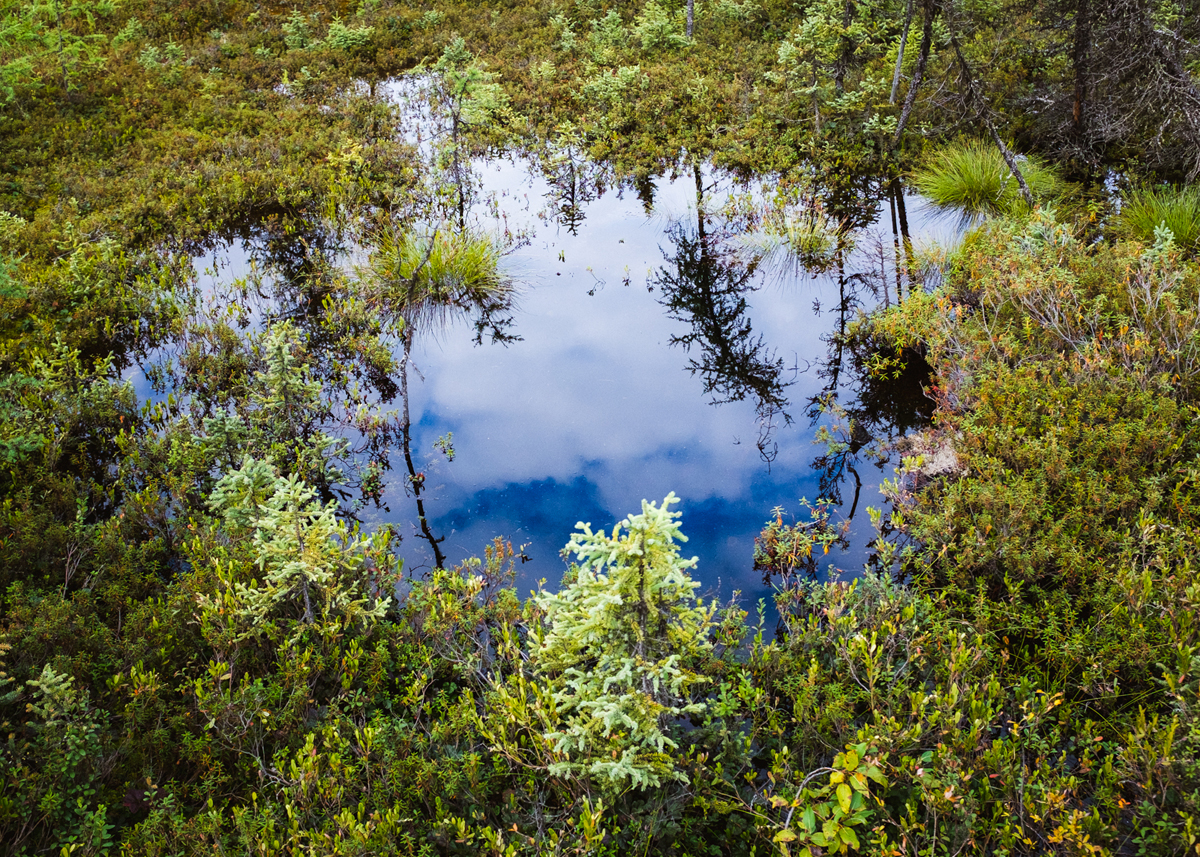
Permafrost thaw outside Nikolai.
This morning, Matthew had woken us up early and herded us a few huts over to visit an old friend of his, an esteemed whale scientist who is currently conducting a bowhead census. Utqiaġvik is a whaling town, and I’ve seen evidence of the spring hunt since I first arrived: up and down the main road, traditional sealskin boats sit on sleds on the edge of the sea ice, flying the flags of their captains.
My first day in town, a truck passed pulling a trailer loaded with meat and baleen. Whalers and scientists have been working together on bowhead population counts since the late 1970s, after the catastrophic effects of industrialized whaling led the U.S. to impose a moratorium on traditional subsistence hunts, which are foundational to Iñupiat identity and survival. Places like Utqiaġvik were thus handed the most painful responsibility for a problem that colonizers had created, even though Iñupiat whalers knew that there were more bowheads than were being estimated. They set out with scientists to prove it, and they were right. Today, bowhead whale hunts remain an important (and highly regulated) part of healthy diet and culture along the North Slope of Alaska. The census team still spends the springtime at something called a “whale perch,” counting bowheads in support of ancient tradition.
We found Matthew’s whale scientist friend, Craig, in the kitchen with a whaler named Billy, who was at a fry pan cracking jokes. They offered us a taste of bowhead meat, and I bit into a piece that was breaded and flaky like tender pork. “Whoa, it’s fishy?”
Everyone looked over at me with curious suspicion. “What did you expect? It comes from the ocean.”
“She’s from Portland,” Matthew explained.
“Is this your first time eating whale?” Craig asked. Yes, clearly. “Record your dreams tonight. People have vivid dreams of swimming under the sea ice.”
One of the world’s leading biologists was directing me to record my whale dreams. Before I had time to digest this, Matthew was moving toward the door. “Time to go!” We were headed to the whale perch, which would take us past snow that Matthew was interested in.
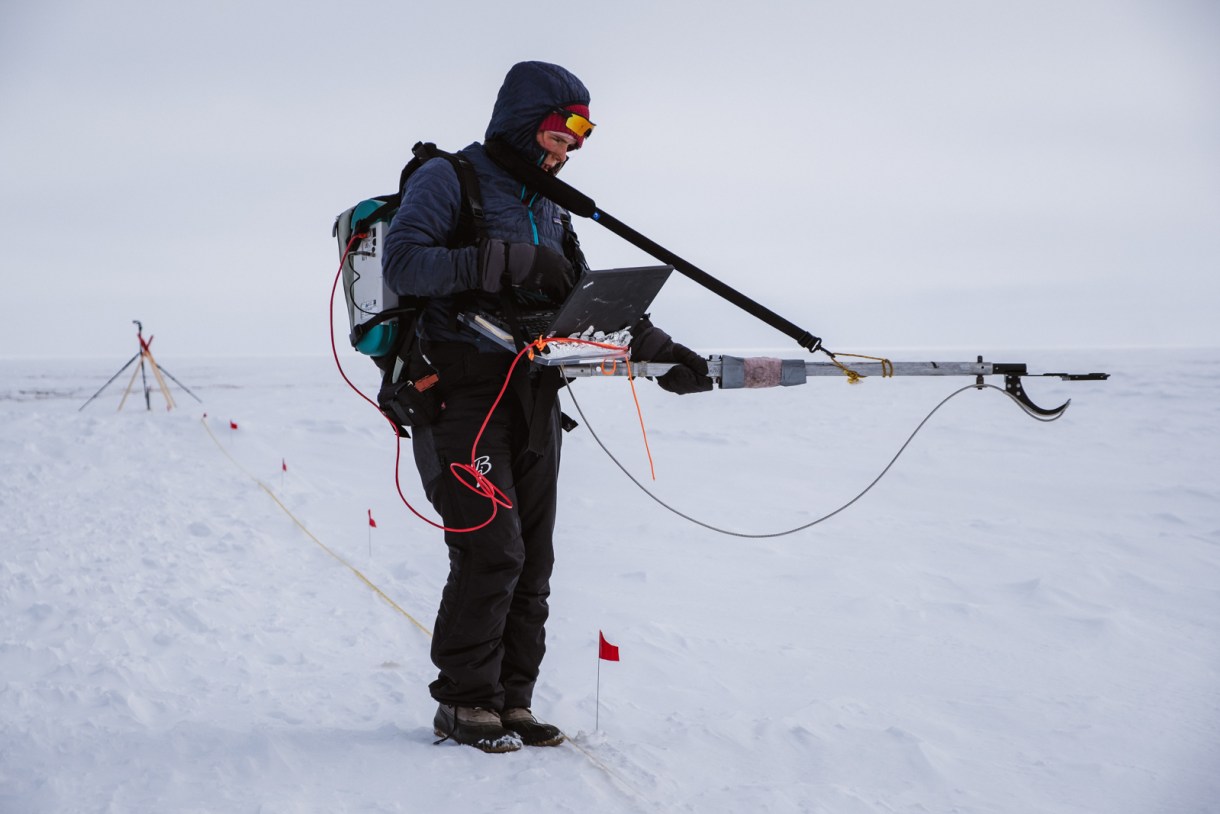
Ema with the “ASD” machine, measuring albedo.
Suddenly, everyone was in a rush. I followed the pack out the door, fumbling with my gloves while others slung rifles over their backs. We’re headed to polar bear country. I’m still trying to keep up now, as we ride up a ridge peppered with small dark pebbles. A crown of bones sits at its top, the butchered remains of a bowhead, with frost-glazed ribs reaching toward the sky and a faint musky smell drifting on the wind. Beyond, our trail disappears into the jagged ice field of the Chukchi sea. I follow it down, past the leviathan into a world removed from the ones I’ve known. Shards of ice frame my path ahead, and I think to myself that Craig was right about the dream, except that I didn’t need sleep to find it.
The Arctic has a way of knocking me off center like this: it lulls me into a sense of familiarity, and then peels back reality to show me that I had been underestimating everything. I think of a place on the Yukon River I visited two years ago during summer, where the rolling banks suddenly split open to reveal veins of dark ice cutting underground. These themselves were once snow, during the Ice Age, when winters got cold enough to snap the ground open. The meltwater from Arctic springtime would flow into the cracks and freeze, expanding year after year for millenia to produce the “ice wedges” that, when they thaw, can swallow up a house. I’ve seen it happen. At this spot I passed on the Yukon, which locals call the Boneyard, woolly mammoth tusks drop into the river as the ground warms and gives way. There’s no way to freeze them back in. It hasn’t been cold enough to grow stable ground ice here for over 10,000 years, and the relics are running an emergency-room temperature. Many people in Alaska build their houses on stilts to keep cold air circulating between their heaters and the frozen ground, but stilts can’t stop the wind from warming. The foundation of their world is collapsing.
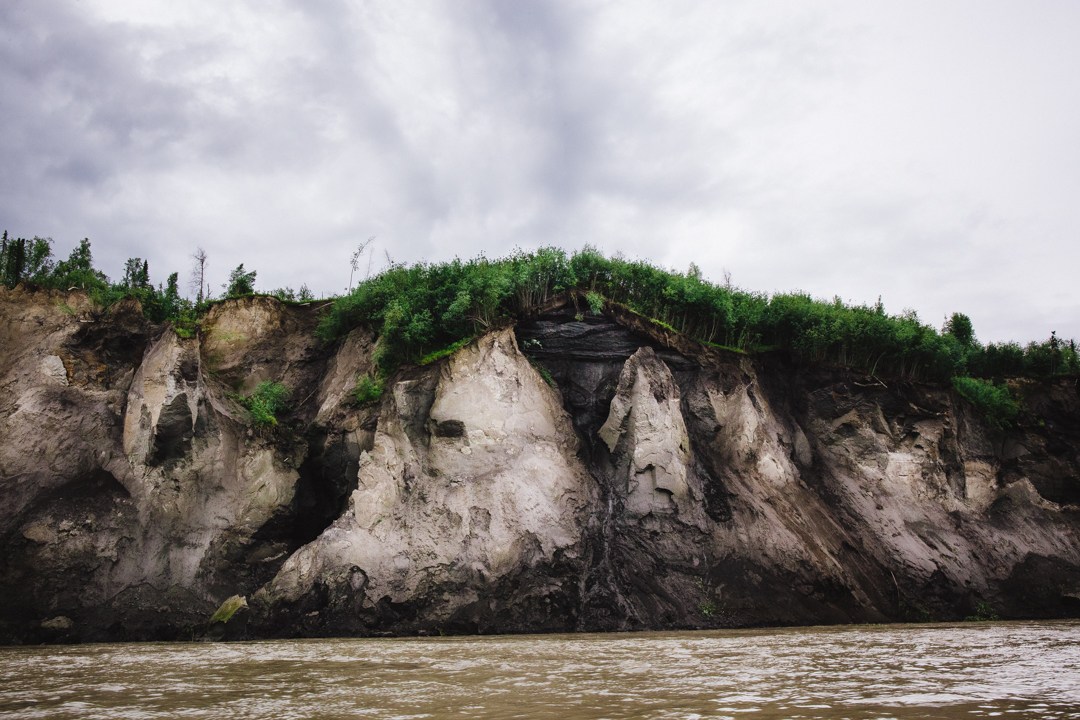
An ice wedge at the “boneyard.”
This ground, called permafrost, was what originally brought me to Alaska for an earlier exhibit project. I remember hoping that if I could witness change in a place that’s warming twice as fast as my own home, if my team could photograph it and sculpt it and write labels to explain it, people coming to our museum would feel its presence and take action to help. Riding my snowmobile across the sea ice, I have time to reflect on what I’ve learned since then, and I think that I was naive.
Last August, I was in the Athabaskan village of Nikolai learning about thawing permafrost. Nikolai is far to the south of Utqiaġvik, where rifles are precaution against the black —not polar — bear variety, and the Indigenous language, Upper Kuskokwim Athabaskan, is a closer relative of Apache than it is Iñupiaq. People in Nikolai depend on permafrost. The local forest needs it, and Upper Kuskokwim culture, health, and livelihood depends on traditional foods from the forest like cranberries, blueberries, moose, and fish.
The permafrost around Nikolai is hovering near the melting point, which is the impending crisis that I had come to discuss. In the end, though, many of my conversations curved back to the changes in my own home, the smoke drifting in through the open windows of my apartment in Portland to choke my partner while they slept. “How are the fires?,” people in Nikolai asked. This was a personal matter for us all. Cash is hard to come by in Alaska Native villages, where there usually are no roads in or out of town, and wildland firefighting is a popular seasonal job. A man who everybody calls Junior was waiting for a call to leave with his fire crew for California, and as we walked around the village, we would talk about fires — the smoke that had become a predictable part of my Augusts and Septembers, which I barely remember from my childhood, and his stories about firefighting, including a time when he was stranded on a mountain waiting for rescue. He likes working outside. So far, Junior has a more intimate relationship with change: he lives with thawing permafrost, and he walks toward the fires that I avoid.
There is danger in this, but I also see a connection to the way people in Nikolai speak about the changing weather, with a calm resolve to adapt. The climate crisis may be a worsening symptom of colonization, but it’s far from the first. The Upper Kuskokwim people are survivors who practice their knowledge of the land day after day. They have managed to resist displacement from their ancestral homelands, and if airplanes stopped landing tomorrow, their elders would still eat well.
Out on the Chukchi sea, we’re now crossing a wide, flat valley of ice, and I think again of white to every horizon and another landscape it reminds me of: flying back home after my time in Nikolai, when I lost sight of the land somewhere over British Columbia. Instead of snow under my feet, it was smoke — hours and hours of it, with only a few mountains breaking the monotony. Sagelands burning.
Here’s where I was naive: by the time my permafrost exhibit began its tour, my region had all the visual evidence of climate change it could handle. It felt like flying into apocalypse.
Since I first came to Alaska, Hurricane Maria has devastated Puerto Rico, Western fires have leveled entire towns, and waves of flooding have crushed farmers throughout the Midwest.
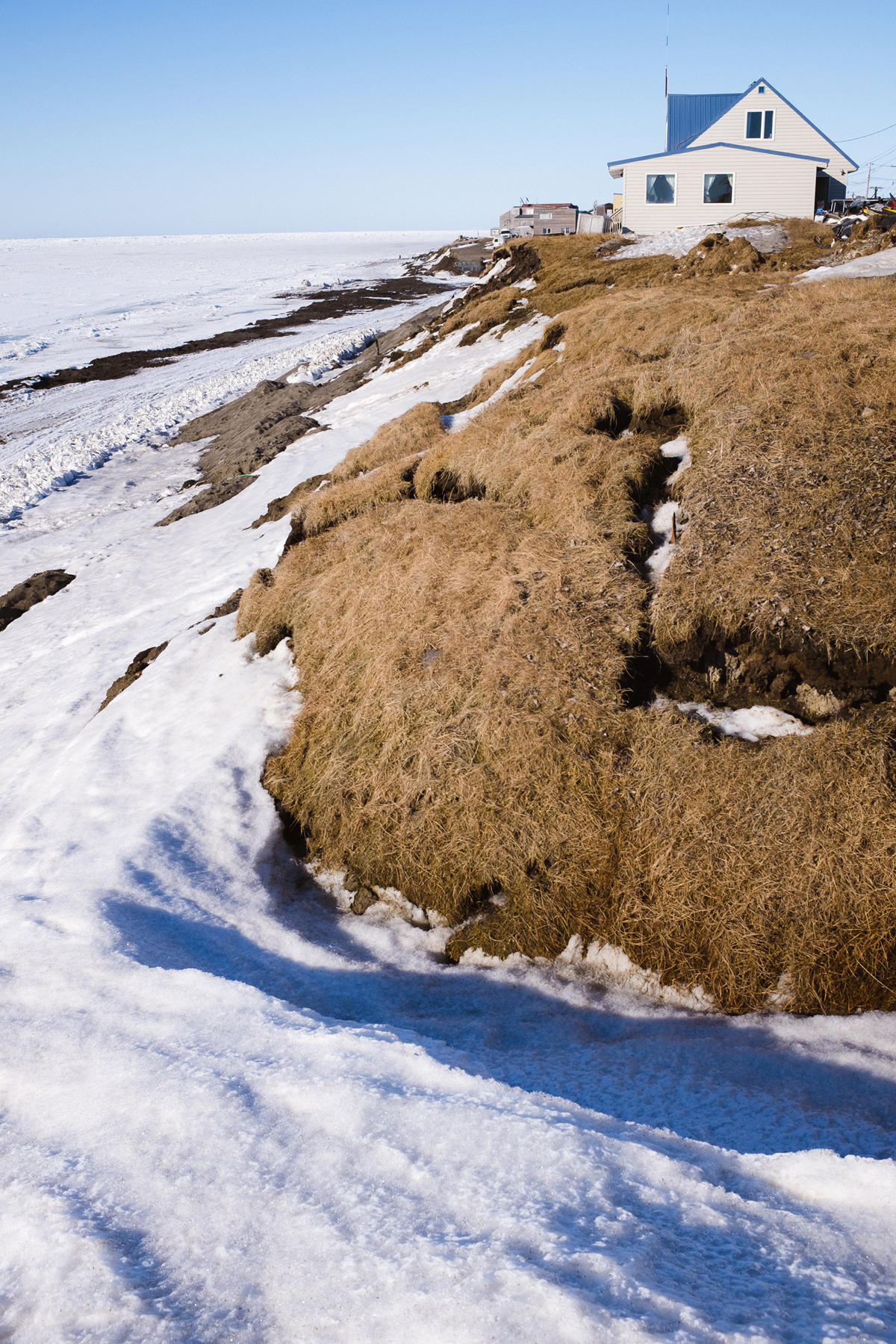
Sea ice used to freeze up outside Utqiaġvik in October, but now it often doesn’t freeze until December, leaving the shore vulnerable to fall storms. As permafrost erodes, this hillside is collapsing
The human impact of this crisis now feels obvious. But when I hear people use the phrase “new normal” to describe what’s happening to us, I see ice. Nothing is “normal,” new or not; it’s a transition into something worse, and unless we take action quickly, the Arctic’s collapse will propel us into something not just apocalyptic, but unimaginable. As permafrost thaws, ancient plants that have been stored since the Ice Age start to rot, releasing heat-trapping gases into the air, further warming the Earth. It’s estimated that twice as much carbon as is currently in our atmosphere is stored in our planet’s permafrost, and we’re pulling it from deep freeze. Taken together, the weakening cooling power of snow and ice and the collapse of Arctic permafrost has the potential to send our planet’s climate into a tailspin we can’t pull out of.
I came North looking for a window into climate’s present, but what haunts me most is this vision of its future, the wrath of an Arctic that we underestimated and ignored. When I sit at my desk in Portland trying to figure out how to explain ice and snow in a way that inspires urgency but leaves room for hope, I’m ashamed to admit that my own mind drifts toward despair. I think about the year I was born, 1988, when the U.S. Senate heard testimony on the threat of climate change, when we had a chance to prevent the worst, and when fossil fuel companies doubled down on misinformation and greed. I think about how I’ve grown up knowing two facts to be true: that climate change threatened me and that the adults empowered by my society would choose fossil fuel money over my future. I think about the warped sense of human nature this creates.
I think about maturing into my own adulthood and for what aging could look like: the satisfaction I feel for coming out and finding my femme-tastic queer badass self, the sweet redhead I want to marry, and the name we will invent for our child to call them — something not quite mom, not quite dad. I think about the young queers I want to nurture and learn from as I grow old, who will remold language and lust and gender and commitment in their own image. I want to know which parts of me they will call old-fashioned and which parts they will call wise. For all this, we deserve the space to dream, not merely to survive.
Sometimes I find that future difficult to imagine. The climate crisis is many things, but among them, it’s a queer issue: sea level rise and associated flooding is coming for urban cultural hubs where we find each other, heat waves and cold snaps will continue to target our disproportionately houseless youth, and Trump’s latest round of attacks on trans access to shelters clarifies that after climate-related displacement, trans and gender nonconforming people — especially trans women of color — are likely to find trauma in the very places that promise relief, which are often segregated by gender. The climate crisis is amplifying social issues that kill the most vulnerable among us.
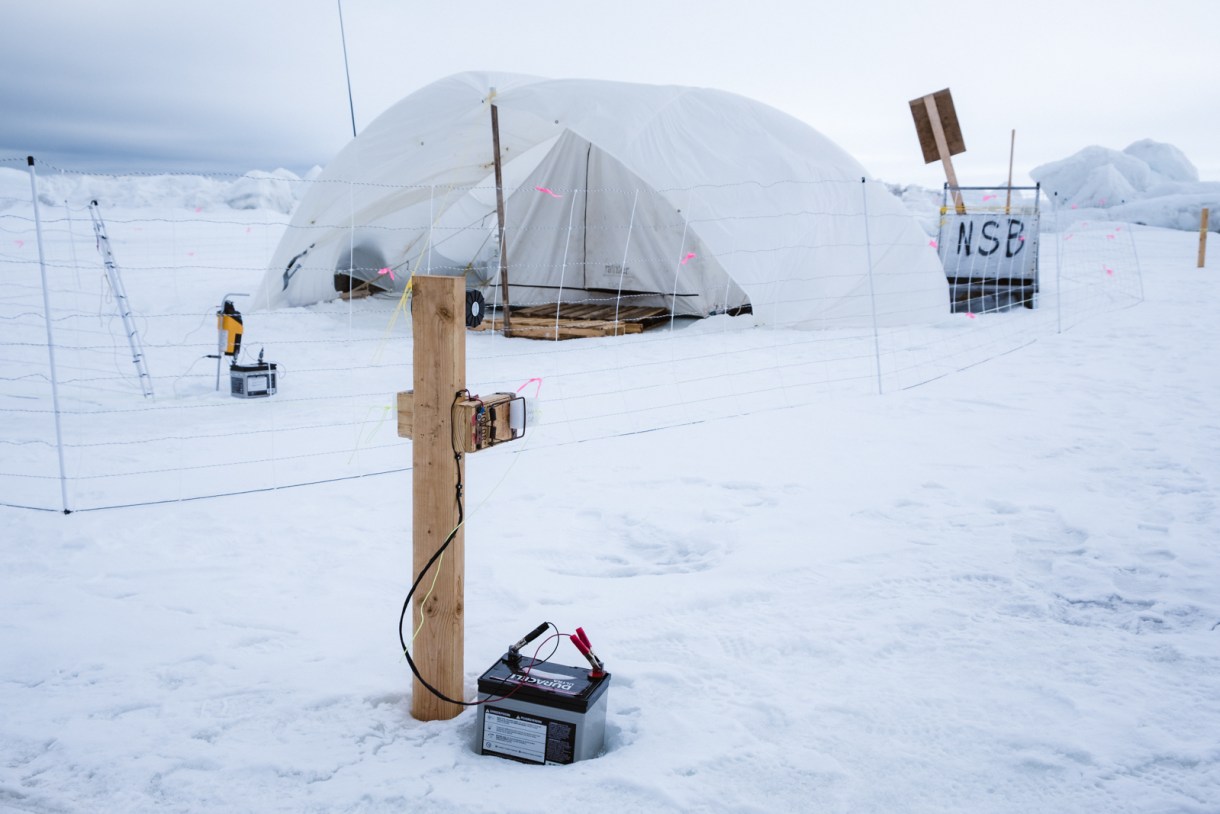
Camp near the whale perch, rigged up with a string wrapped around the tent that sets off an alarm if a polar bear walks into it.
Often, when people hear about my work in climate education, they ask where I find hope. I think people are desperately searching for this, and until recently, I haven’t known how to answer them. I’m not a naturally optimistic person, so some days, reshaping our global economy and the values that govern it feels like a pretty tall order. Hope isn’t really what motivates me, anyway. Our world is dying, so isn’t there a clear moral choice here? I don’t think fate owes me a happy ending as compensation for trying to help. In this way, while our public discussion has fixated on climate denialists, those who trouble me most are climate fatalists: people I know who, because they don’t see what they can do about the climate crisis, believe there’s nothing to be done. People who eulogize a livable world while it’s still alive, to avoid responsibility for its healing.
To be clear, I’m not blaming people who feel despair over the climate crisis, because that’s a rational reaction. I just think that we hold up hope as the tonic for this emotion, and I wish we wouldn’t, because when you’re thinking about massive, systemic issues day after day, hope is fickle. Some days you find it, and some days you don’t. Here’s what I’ve built that’s better, though: connection. The longer I engage with climate issues, the more people I meet who inspire me and the more faith I have in our collective momentum. I feel privileged to get paid for some of this, but the work that’s giving me real comfort is actually unpaid and outside my career, in service to the grassroots climate justice movement I see swelling across the world. I recently found my local chapter of the Sunrise Movement, and I’ve felt what happens when young people stand in unison at a transportation planning meeting, to stare decision-makers in the face. It shakes the building to its foundation. When we gather together, we don’t need to arrive with hope, because we have the power to create it. We will dictate the future.
You and I were born for this decade, for no other reason than we are living it. Other people should have acted thirty years ago, but the deadline is here, and we are rising up to meet it. We must remember that this is why fossil fuel companies have fought so ferociously for a product that they knew was destroying the world: there is nothing impossible about reshaping our economy, but to do it, we must break colonial capitalism’s vice-grip over the world’s resources and its people. This effort must follow the wisdom and leadership of people who fight for their communities: black lives and broken treaties, migrant rights, workers’ rights, clean water, breathable air. Queer organizers have a place in this movement. We can build grassroots networks of solidarity for those suffering displacement. We can popularize words to challenge the artificial barriers that English throws up between people and our non-human universe. We can carve out spaces for radical joy. The movement needs artists to imagine a positive future, trade workers to build it, social workers to help us heal — all pulling together to shape markets based on care and kinship rather than extractive exploitation. All to say: we reject fatalism, and we demand the society that we know is possible.
When I’m old, with the perspective of victories and griefs I can’t predict, I will look back with a debt of gratitude to the people who have shown me their corners of the Arctic.
Sometimes I like to notice moments that I know I’ll remember later as they pass me by, and that’s what I’m thinking as we park our snowmobiles and walk on foot over a ridge toward the open ocean. Above us appears the whale perch, and it hits me as the next in line of Arctic impossibilities. The crew is following a thin trail winding up and up a tower of ice to a tilted shelter quite literally perched above the waves, lashed down against the wind. I should be pondering climate catastrophe, but I’m not. Instead I’m hooting and hollering (as my grandma would say) with unconscious, un-self-conscious glee:
“How does a place like this exist?! HOW IS THIS EVEN REAL??” I follow the path to my group and spend the next hour listening to Alaskans volley stories about albedo measurements, snowmobile expeditions, National Geographic photographers, and the weather. Someone spots a polar bear in the water, and we watch it dive playfully at the ice’s edge. When the bear goes under, it sticks its butt up in the air and then slides straight down, its feet kicked up like a kid’s in a pool.
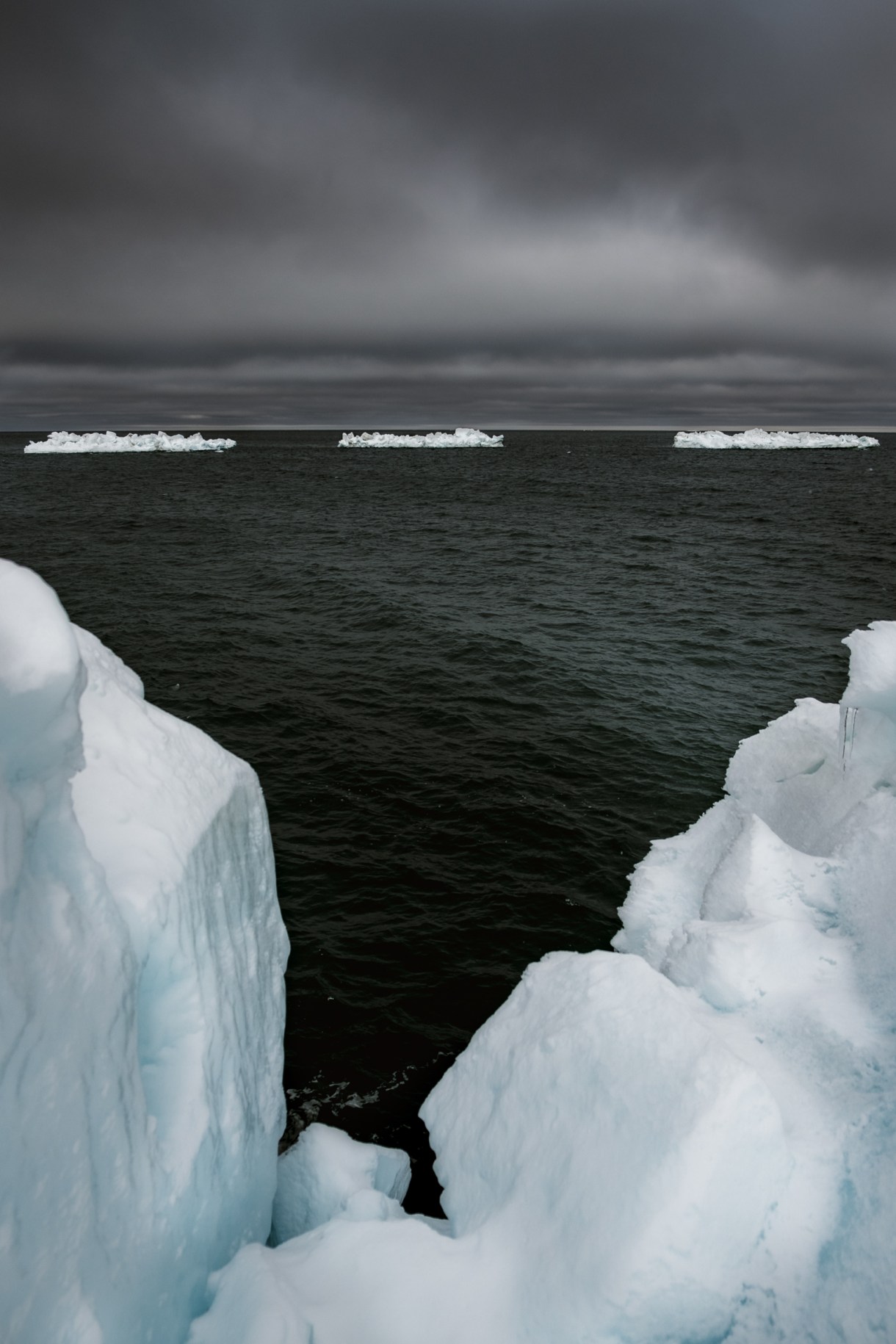
View from the whale perch.
We never see a whale. They’re hard to spot nowadays because what used to be a narrow corridor of open water between shore fast ice and drift ice has grown larger and larger over the years, an opening wound that today stretches past the horizon. Still, the census crew’s count supports a healthy hunt. They’ll be here next year, and the next, and the next. The Arctic is not lost. Its people are resilient. I trust that my queer family back home is resilient, too. This morning, I couldn’t have imagined the magic of this moment, and I wonder: what glorious possibilities will we find that I can’t yet see?🌲
edited by Heather.


Allyson, thank you!
This was beautiful and terrifying and leaves me wondering which kinds of organizing people are doing where I live.
Yessssss I’m sure there’s some wonderful stuff happening!
Wow wow wow. This is so good!
when you wrote “We can popularize words to challenge the artificial barriers that English throws up between people and our non-human universe”, what words or concepts that need words were you thinking of? Super intrigued by this (but also confused).
Yeah, totally! The common English words we use to refer to nature–I’m thinking “nature,” “animals,” “wilderness,” etc., all imply that they’re separate from people, which of course is a v destructive attitude. I know a lot of people are working to redefine these words, which is awesome, and there are also really cool opportunities to challenge their power with new, creative uses of the English language. I love this stuff and can’t wait to see what emerges!
Ooh gotcha! I completely agree. I really hope that we move, socially and linguistically, towards an understanding of the true interconnectedness of all life and all environmental processes.
Robin Wall Kimmerer’s work does this a lot. She has books (Braiding Sweetgrass, and Gathering Moss), and also talks about using the pronoun ‘ki’ for animals and plants (rather than ‘it’).
oh and ‘ki’ is also good for rocks, rivers, lakes, etc :)
Here is a link about Robin Wall Kimmerer’s pronoun work: https://www.yesmagazine.org/issues/together-with-earth/alternative-grammar-a-new-language-of-kinship
What a great/informative/lovely-except-for-the-scary-parts piece, thank you, Allyson. I hope you have plenty of opportunities to see more polar bear butts in the future!
Beautiful essay. I like the way you frame this in terms of connection rather than just vague hope. It’s awesome to see autostraddle publish this, yay science writing!
This was so good! Thank you for writing and sharing. I was also born in 1988, right around the hearing, and think about that too. And I also teach about climate change and find connection through Sunrise!
This is a beautiful and heartfelt piece. I was involved in the climate movement fairly intensely at one point, but I honestly got burnt out-partially because around then I started transitioning, and could only really psychologically deal with one way the government was trying to kill me at a time, and also because (unfortunately) my efforts to get a fossil fuel divestment campaign at the university where I was working on my MS in environmental science failed miserably because no one- not even the members of the environmental science club- was interested*.
Admittedly, that was 5 years ago, before the Sunrise Movement and Extinction Rebellion and the Green New Deal. I wonder if it would be different now?
*Of course, it’s worth noting that that particular university was a total shitshow for a number of reasons, so I guess I shouldn’t be too surprised that its students’ commitment to environmentalism never extended beyond doing a yearly road clean-up and a few half-hearted recycling campaigns.
Oof, I struggled while I was writing this because it’s really fucking unfair that the weight of addressing the climate crisis is falling on people who are already fighting just to exist. I think the more queer folks we can get into the movement the better, but of course I don’t think anybody has an obligation to spend a bunch of time thinking about climate change–self care comes first. I also relate to your experience in school SO hard. Five years ago I was wrapping up an MS in Environmental Studies that, while it taught me a lot, really burned me out and left me feeling like my program was more interested in debating the nature of knowledge (“but how can we really KNOW climate change is happening?”) than helping to strategize actionable solutions.
If you want to, I would encourage you to dip your toes into the Sunrise Movement and see if it’s a good fit. They offer online 101 trainings that give a good sense of the organizing philosophy, and I’d bet that the commitment to big, systemic solutions that center front line communities is going to be so refreshing in comparison to your past experiences. Either way, thanks for reading and sharing your experience!
Wow. This is great and heavy and true. Thanks for writing it and sharing it with us.
Thank you so much for this beautiful piece.